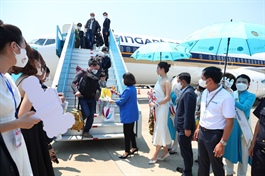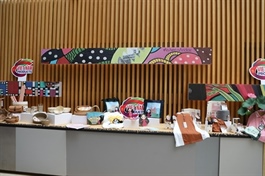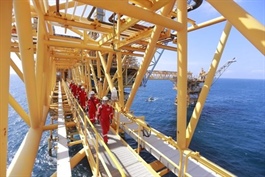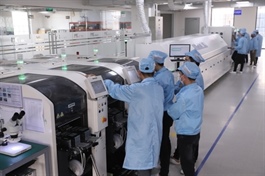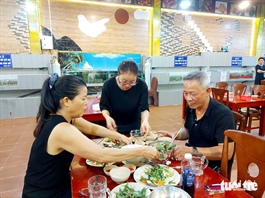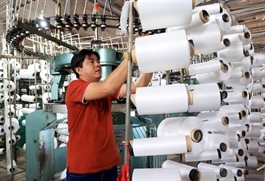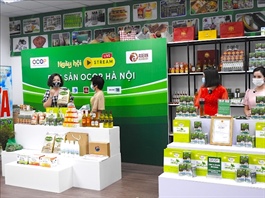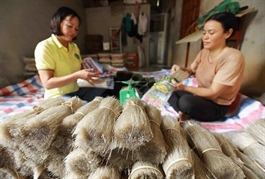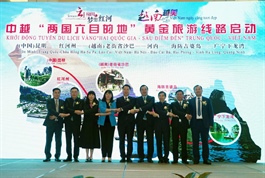Hanoi calls for support in tourism infrastructure: Vice Chairman of Hanoi
Hanoi calls for support in tourism infrastructure: Vice Chairman of Hanoi
At the virtual conference chaired by Prime Minister Pham Minh Chinh today, experts urge visa waivers and simplified procedures to boost tourism.
Hanoi proposes the Government approve the Tourism System Planning for 2021-2030 with a vision to 2045, which contains the development of three potential tourism destinations: Ba Vi National Tourism Area, Vietnam Ethnic Cultural Village - Dong Mo, and Huong Son Tourism Area.
The proposal was given by Vice Chairman of the Hanoi People's Committee Nguyen Manh Quyen at a virtual conference chaired by Prime Minister Pham Minh Chinh on reviving Vietnam's tourism industry speedily and sustainably today [November 15] .

Hanoi's leaders attend the conference. Photo: VGP |
Quyen said that the Government and the Prime Minister had instructed relevant agencies to boost infrastructure and tourism investments in key tourist areas, enabling the city to formulate precise legal frameworks and adopt special support mechanisms for tourism infrastructure development.
He also wanted the Ministry of Culture, Sports and Tourism to assist travel companies in joining domestic and international tourism events and grasping opportunities to potential partners.
"An overall plan should be drawn up to promote tourism in the international market, with the ministry taking the lead. In recent years, Hanoi has cooperated with CNN network in tourism promotion, but we believe that once implemented by the ministry nationwide, it will be more cost-effective and efficient," he stressed.
He predicted that the number of tourists visiting Hanoi would reach 24 million in 2023, an increase of 27% year-on-year. However, this is only 83% of the 2019 figure. "Last year, Hanoi was awarded the "World's Leading Destination 2022" and "World's Best Destination 2023" by international organizations. These titles are advantages for the capital city to attract more international guests."
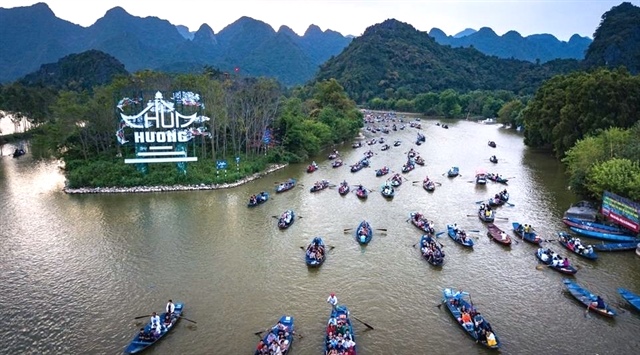
Travelers at the iconic Hoan Kiem Lake, Hanoi before Covid-19. Photo: Pham Anh Tu |
Speaking at the conference, Prime Minister Pham Minh Chinh hoped that the discussion would provide short-term and long-term solutions for the rapid and sustainable development of Vietnam's tourism industry.
"The tourism industry has shown signs of recovery in the first 10 months, with about 10 million international arrivals and 99 million domestic visitors. However, international tourist arrivals were only 69% of the same period in 2019 (the pre-pandemic year). The tourism industry faces numerous challenges and unsolved problems that have persisted for many years," he said.
Chinh stressed the need for stakeholders, from experts to businesses and regulatory bodies, to fix problems related to policies and resource mobilization to develop infrastructure, brands and human resources for the industry. This work includes bolstering management capacity at the national and provincial levels and in each enterprise and enhancing coordination among tourism industry actors.
At the conference, Minister of Culture, Sports and Tourism Nguyen Van Hung explained that the slow recovery of inbound tourism is due to the gradual reopening of some traditional key markets, which have yet to regain their pre-pandemic growth rates. Meanwhile, there is a trend among tourists to choose nearby destinations instead of distant ones, including those in Vietnam.
He added that other factors such as inflation, exchange rate fluctuations, political conflicts and reduced tourist spending have significantly impacted the number of international visitors to Vietnam in recent times.
Hung suggested exploring short-term visa exemptions for tourists from potential and large markets such as China and India to stimulate travel, especially during the low season.
"In addition, the countries with a higher level of development than Vietnam, whose tourists have high tourism expenditure, should be included in the list of unilateral visa exemption, such as Australia, Canada, the US and other European Union countries," he stressed.
He also proposed considering and piloting the issuance of visas at border gates based on on-the-spot personnel approval for international tourists. Pilot programs for long-term visas (3-5 years) could be implemented to attract high-end tourism segments and retired tourists.
"It is important to optimize and simplify the process of applying for electronic visas, ensuring a user-friendly website interface, easy operation, and displaying specific notifications about visa processing times, he added.

A crowd of visitors takes boats to Huong Pagoda in Hanoi's My Duc district. Photo: The Hanoi Times |
Vu The Binh, chairman of the Vietnam Tourism Association, suggested the government end specific policies issued during the Covid-19 period, restructuring the inbound market and the operation of the Tourism Development Fund, especially regarding resource mobilization.
"The majority of businesses are small and medium enterprises with limited resources, so they should have access to preferential financing from the government. We should restructure the international source market in the tourism promotion strategy," Binh stressed.
Nguyen Quoc Ky, Chairman of Vietravel, suggested a reorientation towards sustainable tourism development, stating that the tourism industry needs to update its development strategy.
"We suggest holding more internationally recognized events to attract tourists. Currently, national events are fragmentally organized, posing challenges for travel agencies in marketing and promoting Vietnam's tourism products and national brand," he said.




